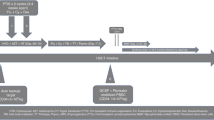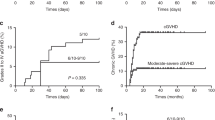Abstract
The outcome of haematopoietic SCT (HSCT) from matched unrelated donors in children with severe aplastic anaemia (SAA) has improved significantly in the last decade and should be offered to all children who fail to respond to their first course of combined immunosuppressive therapy. High-resolution typing for HLA class I and II is mandatory for donor selection. In 10/10 or 9/10 alleles matched donors, a non-TBI conditioning based on fludarabine, CY and anti-thymocyte globulin is sufficient to allow for sustained engraftment when unmanipulated BM is used. Owing to increased rates of cGVHD after PBSC transplantation are reported in young patients, BM is the preferred stem cell source. HSCT from mismatched related and unrelated donors are still high-risk procedures. New techniques for graft manipulation such as CD3/CD19 depletion might improve engraftment and immune reconstitution. In T-cell depleted grafts, irradiation-based conditioning seems to be inevitable to reduce the high risk for rejection.
This is a preview of subscription content, access via your institution
Access options
Subscribe to this journal
Receive 12 print issues and online access
$259.00 per year
only $21.58 per issue
Buy this article
- Purchase on Springer Link
- Instant access to full article PDF
Prices may be subject to local taxes which are calculated during checkout
Similar content being viewed by others
References
Führer M, Rampf U, Baumann I, Faldum A, Niemeyer C, Janka-Schaub G et al. Immunosuppressive therapy for aplastic anemia in children: a more severe disease predicts better survival. Blood 2005; 106: 2102–2104.
Kojima S, Hibi S, Kosaka Y, Yamamoto M, Tsuchida M, Mugishima H et al. Immunosuppressive therapy using antithymocyte globulin, cyclosporine, and danazol with or without human granulocyte colony-stimulating factor in children with acquired aplastic anemia. Blood 2000; 96: 2049–2054.
Locasciulli A, Oneto R, Bacigalupo A, Socie G, Korthof E, Bekassy A et al. Outcome of patients with acquired aplastic anemia given first line bone marrow transplantation or immunsuppressive treatment in the last decade: a report from the European Group for Blood and Marrow Transplantation. Haematologica 2007; 92: 11–18.
Kosaka Y, Yagasaki H, Sano K, Kobayashi R, Ayukawa H, Kaneko T et al. Prospective multicenter trial comparing repeated immunosuppressive therapy with stem cell transplantation from an alternative donor as second-line treatment for children with severe and very severe aplastic anemia. Blood 2008; 111: 1054–1059.
Bagby GC, Meyers G . Bone marrow failure as a risk factor for clonal evolution: prospects for leukemia prevention. Hematology AM Soc Hematol Educ Program 2007; 2007: 40–46.
Kobayashi R, Yabe H, Hara J, Morimoto A, Tsuchida M, Mugishima H et al. Preceding immunosuppressive therapy with antithymocyte globulin and cyclosporine increases the incidence of graft rejection in children with aplastic anaemia who underwent allogeneic bone marrow transplantation from HLA-identical siblings. Br J Haematol 2006; 135: 693–696.
Deeg HJ, Seidel K, Casper J, Anasetti C, Davies S, Gajewski JL et al. Marrow transplantation from unrelated donors for patients with severe aplastic anemia who have failed immunosuppressive therapy. Biol Blood Marrow Transplant 1999; 5: 243–252.
Deeg HJ, Amylon MD, Harris RE, Collins R, Beatty PG, Feig S et al. Marrow transplants from unrelated donors for patients with aplastic anemia: minimum effective dose of total body irradiation. Biol Blood Marrow Transplant 2001; 7: 208–215.
Kojima S, Matsuyama T, Kato S, Kigasawa H, Kobayashi R, Kikuta A et al. Outcome of 153 patients with severe aplastic anemia who received transplants from unrelated donors: the Japan Marrow Donor Program. Blood 2002; 100: 799–803.
Viollier R, Socie G, Tichelli A, Bacigalupo A, Korthof ET, Marsh J et al. Recent improvement in outcome of unrelated donor transplantation for aplastic anemia. Bone Marrow Transplant 2008; 41: 45–50.
Yagasaki H, Takahashi Y, Kudo K, Ohashi H, Hama A, Yamamoto T et al. Feasibility and results of bone marrow transplantation from an HLA-mismatched unrelated donor for children and young adults with acquired severe aplastic anemia. Int J Hematol 2007; 85: 437–442.
Stern M, Passweg J, Locasciulli A, Socie G, Schrezenmeier H, Bekassy AN et al. Influence of donor/recipient sex matching on outcome of allogeneic hematopoietic stem cell transplantation for aplastic anemia. Transplantation 2006; 82: 218–226.
Schrezenmeier H, Passweg JR, Marsh JCW, Bacigalupo A, Bredeson CN, Bullorsky E et al. Worse outcome and more chronic GVHD with peripheral blood progenitor cells than bone marrow in HLA-matched sibling donor transplants for young patients with severe acquired aplastic anemia. Blood 2007; 110: 1397–1400.
Rubinstein P, Carrier C, Scaradavou A, Kurtzberg J, Adamson J, Migliaccio AR et al. Outcomes among 562 recipients of placental-blood transplants from unrelated donors. N Engl J Med 1998; 339: 1565–1577.
Passweg JR, Socie G, Hinterberger W, Bacigalupo A, Biggs JC, Camitta BM et al. Bone marrow transplantation for severe aplastic anemia: has outcome improved? Blood 1997; 90: 858–864.
Benesch M, Urban C, Sykora KW, Schwinger W, Zintl F, Lackner H et al. Transplantation of highly purified CD34+ progenitor cells from alternative donors in children with refractory severe aplastic anaemia. Br J Haematol 2004; 125: 58–63.
Woodard P, Cunningham JM, Benaim E, Chen X, Hale G, Horowitz E et al. Effective donor lymphohematopoietic reconstitution after haploidentical CD34+-selected hematopoietic stem cell transplantation in children with refractory severe aplastic anemia. Bone Marrow Transplant 2004; 33: 411–418.
Kojima S, Inaba A, Yoshimi A, Takahashi Y, Watanabe N, Kudo K et al. Unrelated donor marrow transplantation in children with severe aplastic anaemia using cyclophosphamide, anti-thymocyte globulin and total body irradiation. Br J Haematol 2001; 114: 706–711.
Vassiliou GS, Webb DKH, Pamphilon D, Knapper S, Veys PA . Improved outcome of alternative donor bone marrow transplantation in children with severe aplastic anaemia using a conditioning regimen containing low-dose total body irradiation, cyclophosphamide and campath. Br J Haematol 2001; 114: 701–705.
Chan KW, Li CK, Worth LL, Chik KW, Jeha S, Shing MK et al. A fludarabine-based conditioning regimen for severe aplastic anemia. Bone Marrow Transplant 2001; 27: 125–128.
Bunin N, Aplenc R, Iannone R, Leahey A, Grupp S, Monos D et al. Unrelated donor bone marrow transplantation for children with severe aplastic anemia: minimal GvHD and durable engraftment with partial T cell depletion. Bone Marrow Transplant 2005; 35: 369–373.
Bacigalupo A, Locatelli F, Lanino E, Marsh J, Socie G, Maury S et al. Fludarabine, cyclophosphamide and anti-thymocyte globulin for alternative donor transplants in acquired severe aplastic anemia: a report from the EBMT-SAA Working Party. Bone Marrow Transplant 2005; 36: 947–950.
Eapen M, Ramsay NKC, Mertens AC, Robinson LL, DeFor T, Davies SM . Late outcomes after bone marrow transplant for aplastic anaemia. Br J Haematol 2000; 111: 754–760.
Socie G, Henry-Amar M, Bacigalupo A, Hows J, Tichelli A, Ljungman P et al. Malignant tumors occurring after treatment of aplastic anemia. N Engl J Med 1993; 329: 1152–1157.
Ades L, Mary J-Y, Robin M, Ferry C, Porcher R, Esperou H et al. Long-term outcome after bone marrow transplantation for severe aplastic anemia. Blood 2004; 103: 2490–2497.
Acknowledgements
I want to thank Charlotte Niemeyer and her team of EWOG-MDS for their support.
Author information
Authors and Affiliations
Corresponding author
Additional information
Conflict of interest
Monica Fuhrer has received lecture fees from an unnamed source. M Fuhrer is also negotiating with Genzyme to support an international study in immunosuppressive therapy in SAA in children.
Rights and permissions
About this article
Cite this article
Führer, M. Risk-adapted procedures for HSCT from alternative donor in children with severe aplastic anaemia. Bone Marrow Transplant 42 (Suppl 2), S97–S100 (2008). https://doi.org/10.1038/bmt.2008.293
Published:
Issue Date:
DOI: https://doi.org/10.1038/bmt.2008.293
Keywords
This article is cited by
-
Cotransplantation of bone marrow-derived mesenchymal stem cells in haploidentical hematopoietic stem cell transplantation in patients with severe aplastic anemia: an interim summary for a multicenter phase II trial results
Bone Marrow Transplantation (2017)
-
Haploidentical transplantation for pediatric patients with acquired severe aplastic anemia
Bone Marrow Transplantation (2017)
-
A novel protocol for haploidentical hematopoietic SCT without in vitro T-cell depletion in the treatment of severe acquired aplastic anemia
Bone Marrow Transplantation (2012)
-
Matched Sibling Versus Matched Unrelated Allogeneic Hematopoietic Stem Cell Transplantation in Children with Severe Acquired Aplastic Anemia: Experience of the Polish Pediatric Group for Hematopoietic Stem Cell Transplantation
Archivum Immunologiae et Therapiae Experimentalis (2012)



